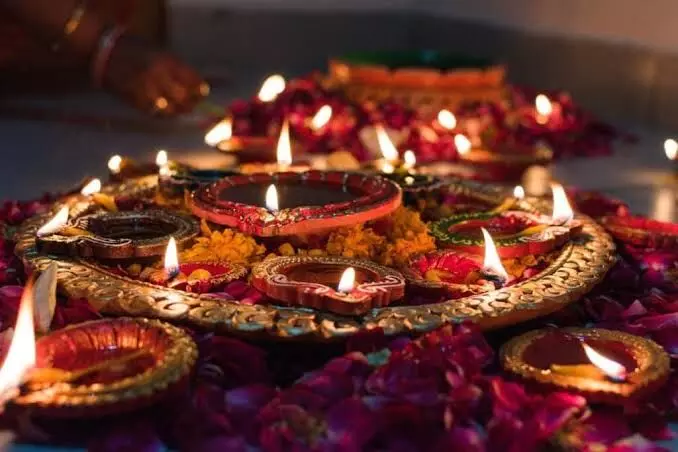Origins of Diwali: Unveiling myths, traditions across India behind the festival of lights
Derived from the Sanskrit words ‘deepa’ (lamp) and ‘avali’ (row), Deepavali means ‘a row of lights
By Anoushka Caroline Williams
Hyderabad: As one of the most cherished festivals in Hindu culture, Diwali, also known as the Festival of Lights, embodies the triumph of light over darkness and good over evil.
Its significance stretches beyond religious boundaries, marking unity, prosperity and togetherness. Hence, it is important to understand the cultural origins of Diwali traditions celebrated across India and the world,
Understanding Diwali’s mythological origins
Derived from the Sanskrit words ‘deepa’ (lamp) and ‘avali’ (row), Deepavali means ‘a row of lights.’ Across Northern India, it is commonly called Diwali, while Southern India often refers to it as Deepavali. This difference in name highlights a deeper cultural diversity as Diwali celebrations reflect distinct traditions in each region.
In the Hindu tradition, Diwali is associated with the return of Lord Rama after a 14-year exile and his victory over the demon king Ravana. Lighting lamps signify welcoming Lord Rama, Sita and Lakshmana back to Ayodhya.
For Jains, it marks the day Lord Mahavira attained Nirvana, and Sikhs honour the release of Guru Hargobind Singh on Bandi Chhor Divas. “Diwali beautifully transcends boundaries within and beyond India, connecting people in a shared celebration,” remarked Professor Kiran Sethi, a cultural historian.
Five days of Diwali
Each day of Diwali signifies unique rituals and beliefs:
Dhanteras: The festival begins with Dhanteras, an auspicious day to purchase gold, utensils or other valuables, symbolising prosperity. Cleaning homes is also a major tradition to prepare for the arrival of Goddess Lakshmi, believed to bring wealth and blessings.
Naraka Chaturdashi: This day commemorates the defeat of the demon Narakasura by Lord Krishna. Early morning baths and rituals mark purification from past wrongs. In Southern India, Naraka Chaturdashi is a primary day of celebration with oil lamps and prayers.
Diwali: On the new moon of the Karthika month, the main Diwali day is celebrated with the lighting of diyas, firecrackers and feasts. Families worship Goddess Lakshmi, invoking prosperity for the coming year. “This day reminds us to reflect on our inner light and let it guide us,” shared Shreya Bansal, a social worker from New Delhi.
Balipadyami: Marked as the start of a new year in some regions, this day is dedicated to feasting and gratitude, honouring Lord Krishna’s protection of his devotees. In Gujarat, this day marks Bestu Varas, the Gujarati New Year.
Bhai Dooj: The festival concludes with Bhai Dooj, celebrating the bond between siblings. Sisters pray for the well-being of their brothers and brothers vow to protect their sisters, reinforcing family ties.
Regional variations in Diwali traditions
Each State in India celebrates Diwali with its own unique twist:
Bengal: In West Bengal, Diwali coincides with Kali Puja. Households worship Goddess Kali, adorned with hibiscus flowers and light 14 diyas on Bhoot Chaturdashi to ward off evil spirits.
Goa: Diwali in Goa centers around the defeat of the demon Narakasura. Communities build large effigies of Narakasura and burn them at dawn, symbolising the victory of good.
Odisha: In Odisha, Diwali honours ancestors through Kaunriya Kathis, a ritual where people burn jute sticks to call upon the spirits of their loved ones for blessings.
Hyderabad: Hyderabad along with the rest of the State, lights up with traditional lamps and modern lights around popular sites like Charminar in the city. Families exchange sweets and prayers for prosperity, blending old customs with contemporary practices.
Diwali’s cultural influence in Hyderabad
Hyderabad’s Diwali celebrations showcase a deep-rooted sense of community.
Bustling markets like Laad Bazaar teem with shoppers buying traditional attire and diyas. Community gatherings fill neighbourhoods with music, dance and local art displays, fostering a spirit of camaraderie. “Diwali is about embracing our heritage while making new memories with family and friends,” said Radhika Kumar, a Hyderabad resident.
Hyderabad’s food culture also shines during Diwali. From Kaju Katli to Double-ka Meetha, local sweets and snacks elevate the festivities.
Diwali’s global reach
Beyond India, Diwali has been embraced worldwide, from Singapore and Malaysia to the U.S. “Diwali is a reminder that festivals carry a universal message, uniting people of different backgrounds,” explained cultural analyst Dev Mehta.
In diverse communities abroad, Diwali showcases a blend of traditional customs, from lighting diyas to hosting communal dinners. In the UK, Diwali celebrations in cities like Leicester include parades, performances and fireworks that draw both Indian diaspora and locals alike.
Embracing sustainable Diwali practices
In recent years, eco-friendly celebrations are gaining popularity as communities work toward noise-free and pollution-free festivities. Noise-less crackers, reusable decorations and community events have become common alternatives. “Sustainable Diwali is about honouring tradition while caring for our environment,” said environmentalist Priya Nair.
The city of Hyderabad has seen an increase in eco-friendly practices, with local groups organising ‘silent Diwali’ gatherings and promoting biodegradable diyas. This shift towards sustainability reflects a growing awareness of environmental impact while preserving the festival’s spirit.